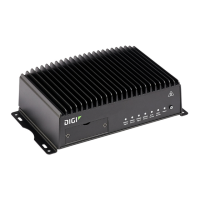Virtual Private Networks (VPN) IPsec
Digi TransPort WR Routers User Guide
194
n Other configuration items
l A description for the IPsec tunnel.
l The number of tries IKE will attempt to negotiate the IPsec tunnel with the remote device
before giving up.
l The metric for the IPsec route. The metric defines the order in which the device uses
routes if there are two routes to the same destination. In such a case, the device uses the
route with the smaller metric. The default is 10 but you can configure the metric differently
to increase or decrease the route's priority.
Example IPsec tunnel
Suppose you are configuring the following IPsec tunnel:
Web
Configure a new IPsec tunnel
1. Prerequisite: A configured LAN must be available for use in the IPsec tunnel. See Configure a
LAN.
2. On the menu, click Network > Networks > IPsec > Tunnels.
The IPsec Tunnels page appears.
3. Click New IPsec Tunnel.
The IPsecpage displays the settings for a new IPsec tunnel. The settings are displayed in five
groups: Network, Authentication, Encryption, Negotiation, and Lifetime. Most of these
settings groups have defaults which you can review and use or modify as needed.The Network
settings involve settings you must supply.
4. In the Select IPsec setting, select a number to assign to the IPsec tunnel.
5. Enter the Network settings:
n Description: (Optional) Description of this IPsec tunnel.
n Enable: Enables or disables the IPsec tunnel when configuration is completed.
n Local IPNetwork: The network used for the IPsectunnel on the local side of the tunnel.
Select a LAN from the list.
n Local Identifier: Enter the local identifier for the IPsectunnel. The value for the Local
Identifier must match the value for the Remote Identifier on the remote device at the
other end of the tunnel.
n Remote Peer IPAddress or Name: Enter the IP address or name of the remote device,
also known as the peer, at the other end of the IPsec tunnel.

